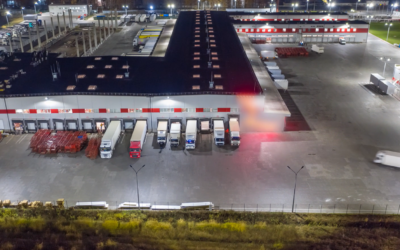The COVID-19 pandemic has had a sudden and significant impact on all aspects of people’s lives with 2.6 billion across the world now living under some sort of lockdown quarantine1. Although the pandemic is first and foremost a human concern, there are knock-on effects that are filtering through the economy and real estate sector that may be here to stay.
Continued logistics operations and re-acceleration for eCommerce players: supply chains remain critical
Throughout the outbreak, deliveries are continuing without major disruption in Europe: only a small portion(22%2) of logistics operators report a sharp decline in activity levels due to (a) no product to distribute or (b) closures for safety purposes — both of which are likely to be transitory. By contrast, a larger portion (38%) report either no change or an increase in activity. The remaining majority of respondents report a moderate slowdown and are taking precautionary measures.
Activity is most resilient amongst operators focused on end consumption and city distribution, especially for e-commerce players. Before the pandemic, consumers were already shifting their spending away from physical stores. With Covid-19, closed stores and shopping centres are forcing consumers to shop online, and this shift towards e-commerce may impact buying habits in the long-term.
Looking further ahead, logistic leaders will have to rethink and redesign their supply chains to ensure operations even through crises. Having a resilient infrastructure will be crucial – more than ever.
Building resilience for the future: re-design of supply chain strategies to omni-channel and automated models
Covid-19 outbreak has increased consumer dependence on e-commerce and efficient supply chains. Customers will become further accustomed to online shopping and home delivery, thus driving up the need to support the various logistic channels at a rapid pace: retail, eCommerce, buy online pickup-in-store (BOPIS), and home delivery. Manufacturers will need to expedite plans to accelerate the shift toward flexible omni-channel logistic models, with a particular focus on mid-size distribution centres and last-mile cross-docking delivery warehouses.
Managing an omni-channel strategy with increased eCommerce orders and labor shortages will place even greater emphasis on automation. Digital platforms will achieve greater visibility and coordination across the supply chain and allow retailers to deal more efficiently with supply chain disruptions, bullwhip effects and permanent changes to higher volumes of each pick order. The current crisis has strengthened the case for automated production lines, picking and order preparation processes, with the objective to improve the speed, accuracy, and flexibility of operations.
These trends are profoundly re-shaping traditional supply chain models: strengthened partnerships between landlords and retailers will need to emerge to support and promote resulting supply chain re-designs.
Re-design of supply chain strategies will have long-lasting impacts on warehouse space
Covid-19 could be a catalyst to ignite an increased demand for logistic space: early evidence from China shows some staying power in the coronavirus-driven shift to e-commerce, which may also further boost already high demands for industrial space. Assuming industry standards of 75,000 sq m space for every €1bn spent online, this indicates a need for an additional 16.7 million sqm of logistics facilities in Western Europe to cater for the growth on online retail over the next five years3.
Will warehouse developers be fast enough to bring new assets to the market and serve this expected increased demand for logistics space? Construction sites are being delayed due to labour and mobility issues and it is likely that some of the development due for completion in the second half of 2020 will not be delivered before 2021. Likewise, some developers are likely to take stock of the current situation before committing to new schemes, which will add further pressure onto Europe’s already undersupplied warehouse market.
With online retailers and 3PLs competing for remaining logistics facilities in response to consumer trends, we generally expect logistics leasing demand to remain resilient during 2020. Separately, lease negotiation periods are likely to be extended and in this respect, it is possible that the rental growth anticipated for 2020 will be delayed until 2021.
A short-term pullback is expected in capital flows as uncertainty builds, but logistics real estate is well-positioned for the long term
In the aftermath of the Covid-19 outbreak, investment activity in global commercial real estate is expected to slow. Travel restrictions and uncertainty around valuation are seriously hampering due diligence processes, and investors are reluctant to execute transactions. Many developers can’t obtain permits and they face construction delays, stoppages, and potentially shrinking rates of return. Meanwhile, landlords and real estate managers are trying to assess what the future is going to bring in terms of asset valuation and operating income, and also which tenants are able to continue paying rent.
Indeed, not all industries are impacted the same way by the coronavirus outbreak. While certain logistics operators such as Amazon, Aldi, Asda and Lidl see an increase in activity and are planning to hire thousands of people. They are not alone – other health and food businesses are also booming and creating a significant number of new jobs within their distribution, packing and production facilities. By contrast, other industries like automotive have been less active.
Similarly, the virus’ impact depends on the real estate asset class. While retail, hotels and leisure are facing increasing challenges, industrial and logistics look set to remain a target for investors in the short and medium term. Savills recorded around £2 billion of offers that have been made on industrial property since the beginning of the the lockdown period in Europe, demonstrating the significant weight of capital flow into the sector.
Finally, not all Covid-19 related effects will last. Some are transitory, causing transaction volumes to recede in the short-term, while transactional liquidity may increase later, due to firms seeking to offload assets due to performance or even bankruptcy. Other consequences will change the real estate landscape permanently, forcing real estate players to alter their strategy to strengthen their position: such supply chain re-designs may yield to repositionings and thus potentially add to the increase in volume of transactions.
While it may be tempting to make reductive assumptions about the coronavirus outbreak’s impact on real estate, the corresponding policy responses at local, national and EU levels will not be uniform across different asset classes and industries. Select real estate players will adapt their strategies to make tailored and well- informed investment decisions.
Notes
- World Economic Forum, April 9, 2022
- Prologis survey, April 2020
- Forrester’s latest forecasts indicate that online retail will account for 17.8% of Western Europe’s total retail sales by 2024, compared to 11.8% in 2019





